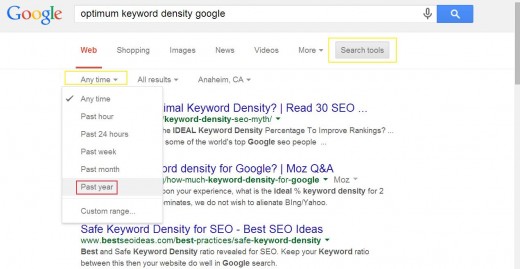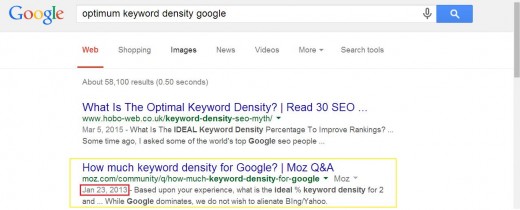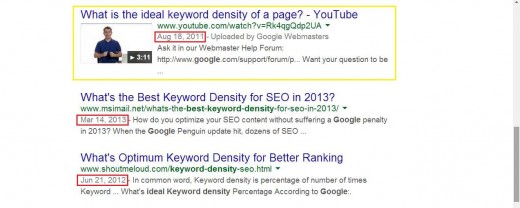Top 3 SEO Tricks You Must Avoid While Marketing
Learning What Works to Optimize for Search Is Hard, but There Are a Few Dangerous Tips That Will Kill Your Rankings
Figuring out exactly how to use Search Engine Optimization while building or marketing your sites to rank well in Google and other search engines is a long, arduous process.
One of the worst aspects of learning the best approach after the implementation of the Penguin, Panda, and Hummingbird algorithms, is wading through all of the old, outdated "tricks" and "secrets" that not only don't work anymore but will absolutely tank your ratings (keyword density being an example of one of the most dangerous considerations that has really changed with updated search algorithms).
Don't get caught up in this advice! Be sure that you completely avoid any practices that are now penalized during search indexing.
Quick Tip to Avoid Outdated SEO Tricks
When you are searching for information on how to best optimize your content, make sure that you make extensive use of the advanced search options that allow you to restrict your search by the age of the result.
There is absolutely no point in wasting your time with articles that were written three to four years ago, or worse!
For those who don't already know how to do this, it can really be a huge time-saver compared to manually going through pages and pages of results to try to pull out those that are most relevant and updated.
Basically, during your given search, you need to select the "Search tools" option that shows up just below the main query entry box. This option is in the same line but to the far right of other search sorting functions such as "Web", "Shopping", "News", etc.
Here's an image showing how you can force Google results to only display the results with a given age (and where to click):
Google Search Tools Limit by Date

Old Sites Often Rank Highly
When I am searching for current content optimization practices, I often find suggestions from 4-6 years ago ranking high in a basic search for the best SEO tactics.
That isn't helpful for anyone today, and this advice will may actually hurt you these days.
Does a YouTube video on the keyword density tactics from 2011 sound like the best way to learn about SEO now?
See below for an example of the outdated links which undoubtedly give bad advice for modern times that pop up during the search for "optimum keyword density google":
Outdated Results Ranked in Example Google Search


Was Searching by Date New to You?
Did you already know about the Google search by date feature?
Old Trick to Avoid #1: Keyword Stuffing
This is probably the worst of the outdated suggestions that still seem to be employed by a lot of SEO gurus who were once king of the hill but are past their expiration date now.
The Hummingbird update has a lot of components, but one of the main goals is to ensure search results that are useful to their readers; this includes penalizing sites that are keyword stuffed and low on useful content.
This issue is particularly complicated by the fact that it is still important to make sure your keywords are present to a certain degree within your content.
However, it spells death to your rankings to try to cram in a particular keyword more often than what the new algorithms will deem to be "natural" (this naturalness factor will be explained below).
Bad Advice Refuses to Die
The old way, which is now heavily penalized, was to cram in a given keyword like "red metal toaster oven" into the content 10-20 or more times. The thought process was that the more often the keyword was present (higher keyword density at 10% or more), the higher that content would rank in the search results.
In the olden days of yore, this practice often worked, which is exactly why it is embedded like cancer into SEO discussions even today.
The problem is, search engines actually penalize keyword stuffing now! Google has realized that readers don't want to read content with keywords crammed into it; they want content that is actually readable and useful.
Experts Debate Even Now
Even though I only search for current SEO topics written by legitimate authoritative experts from the last six months to a year, I am still often finding a lot of conflicting suggestions. Some claim you need at least 3% density with 4% preferred, while others say that going above 2% density is going to prevent your site from ever ranking.
Well, which is it? What density should you really use for a given keyword?
Give up? That is a Trick Question!
Each Keyword Has Its Own Unique Optimum Density Based on How Often It Should Appear in Natural Writing
There is no longer a given density that is ideal for any and all key terms and phrases. Instead, search engines have gotten smart and realize that a naturally written piece about a given topic will contain these words a given number of times.
So, they collected a huge database of naturally written content and analyzed it to find how often a given word will naturally appear in content that is useful and desirable to their searchers. This is what your content will be compared to when determining how optimally dense you are making your keywords.
The basic concept behind this is known as term frequency–inverse document frequency (TF-IDF).
This is only a small part of the overall picture, but it is quite important when thinking about how often to use your keywords.
Take Away: Don't Assume One Necessary Density
Don't ever approach every document assuming you need x% density for every keyword. Instead, think about how often the keyword will fit in naturally.
Using semantic variations of your targeted phrases is also very important due to LSI (Latent Semantic Indexing), which has become more and more relevant.
It is also a smart move to analyze the top competitor results for your desired top keywords to see what density they are using for your terms and mimic them.
Panda and Penguin Will Get You
Old Trick to Avoid #2: Low Quality Back-links
The days where it was wise to buy hundreds of back links in bulk from low quality sources are long gone.
When the Penguin algorithm was implemented in 2012, it started targeting links that appeared to be artificially created or manipulated.
Not only has Google publicly declared just how strongly manipulating links will tank your ratings, they have explained exactly what they don't want to see.
They do not want you to buy links, period. In reality, you can still buy links and some SEO experts advise that you need to do so. However, you must build back-links slowly and from reputable sources.
These are the primary aspects that they are able to analyze: how many links appear overnight and which crappy sources have linked to you.
If your site is linked to by 500 other sites overnight when you have never gotten more than a couple back-links organically, then they know darn well that you have started buying links or instituting some other shady method.
Buying Cheap Links Will Kill Your Site
If you try to buy links from a dude who claims he'll post onto 500 different sites for $10, Google is going to trash your site in their rankings.
Don't think for even a second that you are somehow going to slide this kind of bulk shenanigans past them.
This sort of advertising and black-hat style marketing still exists because of how well it USED TO work, but it does not work anymore and will result in your site being penalized.
If you must pay for back-links to establish your site, be sure that it is from someone who will gradually slip in reasonable quality links over a longer period of time instead of spamming to junk sites all at once.
Old Trick to Avoid #3: Duplicated or Awful Content
There is no question these days about whether duplicated content is alright. It must definitely isn't.
The Panda algorithm change kicked in during February of 2011. The primary focus was to seek out and destroy (or at least un-rank) duplicate and low quality content.
Duplicated content will set off a search engine's junk alarm faster than my attempts at heating bread in the oven set off the fire alarm. Besides being illegal if it isn't your own content, there is zero chance you are going to slide this past as quality content.
And no, it isn't fine as long as you swap out a couple keywords and throw in a few synonyms. It is still going to be detected as a complete steaming pile.
Cheap, Junk Content Is Hardly Better
Don't think that being unique is the only factor that matters. Having junk content that barely reads as English is not going to do your site any favors.
I have seen ads offering $0.50/article or 100 articles for $10 all over the place online.
However, there is not a chance in hell that these articles are going to give you the quality you need. Usually, they are written by someone who barely grasps the English language at all, and they are often composed of "spun" content that originally belonged to another writer.
Content that is "spun" using automated software often looks like a complete joke. You wind up with "whenever that determinant for baby wounds" when it originally would have been "sometimes this results in minor injuries".
Don't get sucked into the low quality content!
Make sure your content is written with proper grammar and provides information that will be useful to your readers. SEO tricks, marketing, and worrying about keywords and back-links won't get you anywhere if your site is a waste of space to begin with and Panda, Penguin, and Hummingbird are out to get you.








